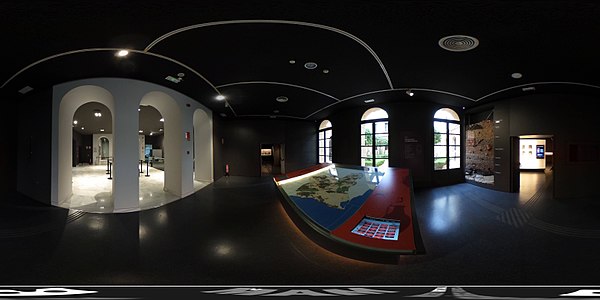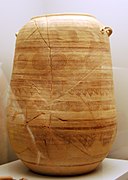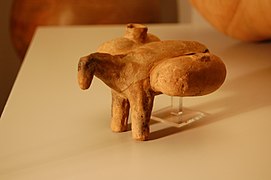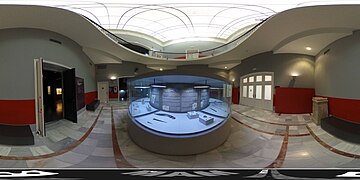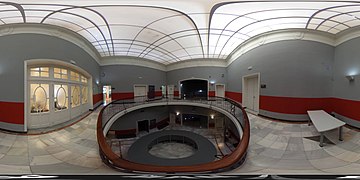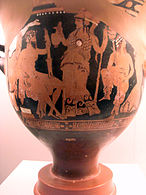Archaeological Museum of Murcia
The Murcia Archaeological Museum is located in the city of the same name, in the Region of Murcia (Spain). It has its origins in the old Provincial Museum which was created by Royal Order of the Ministry of Public Works on July 6, 1864 thanks to contributions from the Provincial Monuments Commission. Its first venues were the Teatro de los Infantes (1864), the Contraste de la Seda building (1866) and the current Museum of Fine Arts of Murcia (1910).
In 1953, the archaeological collections of the Provincial Museum were moved to the current building, built between 1941 and 1953 by Luis Moya Blanco and José Luis de León for Casa de la Cultura, giving rise to the Archaeological Museum of Murcia. In 1962, the Archeology collection and the building were declared Historic-Artistic Monuments.
General Information
- Direction: Gran Vía Alfonso X, 7 (Casa de Cultura).
- Timetable:
- Winter: Labour: 10-14 and 17-20. Saturdays and Sundays: 11-14. Monday and holidays: closed.
- Summer (July and August): Tuesday to Friday from 10 to 14. Saturdays and Sundays: 11-14. Monday and holidays: closed.
- Entry: Free.
- Location:
Access
Access to the Archaeological Museum of Murcia is made from the Gran Vía Alfonso X, one of the main arteries that make up the city of Murcia. On the ground floor there is a reception and information area, along with other services, such as a terrace and a cafeteria.
Archaeology
In the museum there is a permanent exhibition of archeology of Murcia and its region from the Paleolithic to the Late Roman era. The section on medieval Islamic archeology is currently on display at the nearby Santa Clara Museum.
Ground Floor
- Room 1: Designed as an introductory space to the museum, the room presents a model of the Region of Murcia and a virtual tour through its main archaeological sites, ordered by cultures and municipalities.
- Room 2: Dedicated to the paleolithic. During this dilated cultural period, since it covers from the origin of the hominids (more than two and a half million years ago) to the climatic changes of the Holocene (about ten thousand years ago), humans evolved as a species, knew the fire and developed different technological advances within a subsistence economy based on hunting, fishing and harvesting. In the case of the Murcia Region, the period is well documented from the Middle Paleolithic. Collections from musterienses sites such as Las Toscas (Molina de Segura), Cerro de la Fuente (Yecla) and Cueva Antón (Mula) are presented in the room, highlighting also the epipaleolithic group of the Algarrobo Cave (Mazarrón). An audiovisual about human evolution explains the steps of human evolution, while another one teaches us the variety of paleolithic critiques and their functionality.
- Room 3: Dedicated to the Neolithic. A decisive period in the history of human evolution (VIII-IV millennium B.C.), is characterized by the gradual sedentarization of societies and the beginnings of agriculture and livestock, following slow and unequal processes of experimentation. In the room, a hut model has been rebuilt and the collection of decorated ceramic fragments from the Hondo del Cagitán (Mula) site and a set of axes of neolytic-eneolithic tradition are displayed in the enclosed vitrine.
- Room 4: Focused on Prehistoric Art. From the Upper Palaeolithic period and until the Bronze Age, the European communities developed the first manifestations of an aesthetic and symbolic intention that can now be defined as art. The relevance of the demonstrations of rock art in the Region of Murcia has made its declaration by UNESCO as a World Heritage Site on December 2, 1998. In the room, two audiovisuals are projected in parallel form: one shows the process of performing a painting and the other reproduces, on the stage of a cave, the calcos of the main prehistoric paintings known in the region.
- Room 5: Dedicated to the technological advances that enabled prehistoric societies to better adapt to the environment and a gradual improvement in their living conditions. In the room, three videos show the realization of lytic, bone and ceramic utensils, while a selection of useful in different processes of realization and with different degree of complexity, emphasizes the concept of evolution.
- Room 6: Recreates an Archaeology workshop. A laboratory environment, with different analytical instruments and replicas of archaeological objects, show the scientific character of Archaeology and its value as a science that allows us to decipher the keys of our past.
- Room 7: Dedicated to Calcolytic. Between the fourth and the second millennium BC, numerous transformations in settlement patterns and in the funerary world reveal the emergence of more advanced societies. During the period, significant technological advances occur, including the appearance of copper metallurgy. In the first part of the room, dedicated to everyday life, the model of a calcolytic house is shown along with several vitrines with a selection of lytic, metallic and ceramic materials that explain the development of economic activities in the villages, highlighting that of Murviedro (Lorca). In vitrina 4 you can contemplate a valuable set of campaniform elements, a cultural horizon of European diffusion on horseback between the Calcolytic and the Bronze Age. The heterogeneity of the typical burial rituals of the period is explained in the last part of the room; the vitrinas exhibit here funeral rivets belonging to different sites with multiple burials such as Barranco de La Higuera (Fortuna), Loma de los Peregrinos (Alguazas) and Murviedro, while an audiovisual describing the process of building a funerary megalithic monument.
- Room 8: Focused on Death Archaeology. An audiovisual brings us to the world of death and beliefs in Prehistory and explains how the study and analysis of funeral practices help to know many details about past societies.
- Room 9: Dedicated Argatric Bronze. The second millennium a. C. in the southeast of the Iberian peninsula is represented by a peculiar cultural horizon and very defined traits, which today is known as Argar culture. An interactive introductory edition allows us to look at the facsimilar edition of the book The first ages of metal in the southeast of Spain, of the Siret brothers, pioneers of Archaeology in the area and especially of Arganic culture. In vitrina 2 a series of high quality ceramic materials are presented, including the lacking vessels of La Bastida de Totana, the cup of Cabezo Negro (Lorca) or the lenticular glass of Monteagudo. In the following vitrin, materials that explain the proliferation and generalization of the use of metals such as copper, bronze and silver for the realization of usefulness, weapons and ornaments, being very significant the sword of the Gorda Head and the dagger of eight rivets of Monteagudo. Then the recreation of the Y/Z house of the El Rincón de Almendricos (Lorca) introduces us to the daily life of an Argarico village. Together, it exhibits characteristic materials such as millstones, ceramics, loom weights, lytic and bone industry and owl fragments from deposits such as La Bastida and the Almendricos Corner. The archaic funerary world is characterized by the inhumation of the bodies in the interior of the villages or in the areas near them. A large vitrine shows different models of Arganic burial in urn, cyst and double urn of the deposits of Puntarrón Chico (Beniajan, Murcia), Los Molinicos (Moratalla) and Loma del Uncle Ginés (Puerto Lumbreras). In vitrinas 6-7 there are exceptional material sets found in two important archaeological sites of the Region of Murcia, such as Monteagudo and the Bastida de Totana. In vitrina 8, dedicated to funeral rivets, stands out the number 1 of the Rincón de Almendricos, in Lorca.
- Room 10: Dedicated to the final Bronze. At the end of the 1st millennium BC, the human communities of the south-east peninsula experienced a series of transformations as a result of the overlap of various cultural contributions from Atlantic and European bronze and later from the Mediterranean. Over the course of the period, survivals of previous times are seen, but new forms of exploitation of natural resources are also detected, an increase in exchange networks, the development of metallurgical activities and the introduction of important technological advances. A series of metallic materials are displayed in the room, including the ax of a lateral ring of Atlantic-type technology from Peña Rubia (Lorca). The set of materials from the funeral complex of Los Ceperos (Lorca) shows the adoption of incineration in the burial rituals of the period. Complete the room an interactive with the large cultural groups of the European final bronze and the Phoenician trade routes in the Mediterranean.
- Room 11: Focus on metal technology. Metallurgy is one of the most important technological advances in the recent Prehistory. The room explains the metallurgical process with an audiovisual projection and the exhibition of different materials related to mining and metallurgical work.
Top Floor
- Room 12: Dedicated to the appearance of writing as a key element that involves the transit of Prehistory to historical societies. In this room different alphabets are projected known in the Mediterranean, such as the Phoenician, Greek, Iberian and Latin.
- Room 13: It focuses on Iberian culture. The internal evolution of the indigenous societies of the end of the Bronze Age and the contributions made by the peoples of the Eastern and Central Mediterranean (Phonic-Cartagines, Greeks and Etruscans) promoted the development of the Iberian culture in much of the peninsular territory between the 7th and the 1st centuries. In the first part of the room there are materials from the Los Molinicos (Moratalla) site accompany the recreation of a house of the same site and bring us closer to the forms of Iberian economic exploitation and the development of life in the towns. Glasses 3 and 4 exhibit ceramic materials that show the formal and decorative evolution of Iberian ceramics. Along with the splendid ceramic sets, an audiovisual recreates a potter by making a canate. All of this highlights the important development in the specialized pottery production that resulted in the proliferation of the use of the lathe. Among the exposed materials, stands out the canate of the 500th century Verdolay tombIIa. C., and a bitronic glass with zoomorph decoration of great realism known as “goats and fish wine”. A good selection of static, punica and Rosas ceramics can be seen in the room dedicated to the trade, with specimens such as the attic skyfos of the Castillejo de los Baños (Fortuna), the craters of the Cabecico del Tesoro (Verdolay, Murcia) and Galera (Granada) or the enocoe of red figures from Alcantarilla. The Iberian religious world, which undoubtedly influenced indigenous elements and other areas of the Mediterranean, is well represented in the room by means of the extraordinary materials found in the Sanctuary of La Luz (Verdolay, Murcia), among which the collection of bronze exvotes and the head of a goddess is made in stone. Iberian society is well known thanks to the funerary ajuars recovered in the necropolis, as in them the differences of status and gender are appreciated. In this room, ajuares belonging to warriors, with extraordinary panoplys, such as those found in the 597 tomb of the Head of the Treasury and that of the 7th tomb of the Castillejo de Los Baños, are exposed. The processes of transformation of Iberian society are explained by the analysis of the evolution of the ajuars appeared in the necropolis of the Head of the Treasury, from the fourth to the I. C., which links in this way with the process of romanization of the territory. Finally, a series of sculptural elements found in funerary contexts, including the funerary monument of Coy (Lorca) and the headquarters sculpture of the Verdolay, reveal the artistic development achieved in the Iberian era.
- Room 14: Rome Room. From the centuryIIa. C., the indigenous peninsular societies are immersed in a profound process of transformation motivated by the Roman conquest of the territory, after the clashes between Romans and Carthaginians at the end of the centuryIIIa. C. The importance of the mining wealth of the southern peninsular explains the efforts of Cartago and Rome to control the region, so an audiovisual, together with the exhibition of a significant collection of mining objects from Mazarrón and Cartagena, serve to learn more about the economic significance of this activity during that period. Also in this first part of the room you can contemplate materials from the republican period, among which special attention is the set of terracottas coming from Calvi and the mosaic with registration of the Loma de las Herrerías (Mazarrón). The region had trades with the border areas and with Rome, so the recreation of a boat explained the continued flow of commercial activities in the Mediterranean. Mining and agricultural and fishing activities attracted colonizers and traders and encouraged the emergence of elites, the gradual growth of urban nuclei and an important process of monumentalization of the cities, especially relevant in the southeast peninsular in the city of Cartago Nova (Cartagena), which has been recreated in a model. Urban growth and differences of wealth and social position generated various architectural solutions to accommodate the population. The domus in the urban centers and the villa in the rural areas are the characteristic models of the period. In the room are displayed elements of tableware and house ornamentation with examples of mosaics and parietal decoration from the Paturro villas in Portman (La Unión) and Los Torrejones (Yecla). Another vitrine exhibits objects related to personal ornamentation and hygiene, such as needles, glass ointments and amulets of various origins. Finally, it is worth highlighting the sculptural set consecrated by the dispensator Albanus de Mazarrón, the Hercules de Los Torrejones (Yecla), the Pudicitia de Cartagena, the hermae found in the Monroy street of the same city and the sculptural fragments from the village of Paturro. At the end of the room is displayed an epigraphic collection of commemorative and funerary character and the aras of Begastri (Cehegín) and Monteagudo (Murcia).
- Room 15: Focused on Ancient Christianity and Visigoth Period. Very diverse factors, such as the continued pressures on the borders of the empire and the growing autonomy of the provincial aristocracies, caused a deep crisis in the Roman state and society. Imperial authority remained until an advanced time of the centuryVd. C. on the Moorish coast, but the constitution of the Visigoth kingdom at the end of that centuria caused its disappearance and the consolidation of the local aristocracies, supported by agricultural and livestock latifundism as an economic model. The continuing crisis of the Visigothic monarchy facilitated in the mid-centuryVId. C. an ephemeral Byzantine occupation, under the emperor Justinian, of the peninsular southeast and of Andalusia. Important architectural elements from the Martyrium of La Alberca are shown in the room in the mid-centuryIVd. C. and one of the most important buildings of the Tardy Antiquity on the Iberian peninsula, and the Basilica of Algezares, dated in the centuryVId. C. and described as an important religious complex belonging to the local aristocrats of the time. Also noteworthy are the fragments of sarcophagus from Murcia and Los Torrejones (Yecla) along with a splendid lot of tardoantiguous materials from the dredging of the Port of Mazarrón (Mazarrón) and the Salto de la Novia (Ulea).
- Room 16. Audiovisual. Visions of Archaeology. The tour of the permanent exhibition halls is closed with an audiovisual showing different moments of the work of the archaeologist, from the exploration and excavation of the deposit to the study of the materials in the laboratory.
Heraldry
Finally, in the inner courtyard, a wide selection of the collection of heraldic shields from noble Murcian, Renaissance and Baroque buildings is on display.
Common areas and services
The Archaeological Museum of Murcia has a series of dependencies and services available to visitors, research, restoration and other activities related to its purposes.
First Floor
Second Floor
On the Second Floor, in addition to institutional administration spaces, there are:
Activities
The MAM, in addition to carrying out guided tours and specifically oriented to educational and school activities, develops multiple activities, such as Temporary Exhibitions, The Piece of the Month, The Night of the Museums, together with various research projects in the museum fields, museographic and, mainly, oriented to archaeology.




